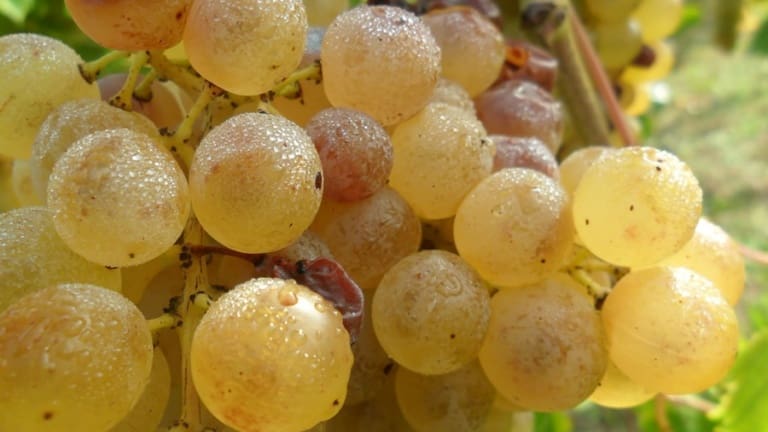Albana di Romagna DOCG Wine Guide

Albana is the white wine par excellence in Romagna, practically every winery from Imola to Rimini produces Albana. Highly appreciated in the Albana passito version, respectable interpretations of dry Albana are emerging: an interesting wine for its particular characteristics that make it pleasant and suitable for an infinite number of combinations with food, but above all unique, thanks to the presence of tannins. A little curiosity before going ahead: the Albana di Romagna was the first white wine in Italy to receive the DOCG recognition in 1987, just to make you understand that we are talking about a historic wine, not Tavernello.
Once in Romagna the Albana was the classic peasant wine, turbid, hyper-perfumed, oxidized and sweet until fainting. Today, fortunately, times have changed and Albana di Romagna is experiencing a second youth, with the winemakers who have just begun to discover how much satisfaction this ancient vine can give, which it is good to say grows only Romagna.
History of the Albana di Romagna
The first to speak to us about Albana is, as usual, Pliny the Elder and the Younger, who describe Albana as an excellent wine, valuable and of the same opinion is also Cato, a frugal person who had a certain palate for good wines. The daughter of Theodosius, Galla Placidia sings the praises: “Not so humbly I should drink you, but (ùI should drink you) in gold, to pay homage to your suavity”. Thus was born the myth of the nectar streaming from the Romagna hills and from that day that place-village is called Bertinoro (Drinkyouingold): the most famous cru of all Romagna. In reality “Albana” seems to come from the Latin Albus (white), and the grape variety should have arrived in the Cisalpine Gaul with the Roman legionaries during the first military campaigns.
The first chronicler to speak of it extensively is the Bolognese Pier de’ Crescenzi in 1200 in his famous Treaty of Agriculture.
Organoleptic characteristics: what does Albana di Romagna taste like and how to recognize it

The bouquet is moderately intense, never explosive, but the situation changes when we move on to the palate. The Albana has a powerful structure, salty body, good sapidity, and lively tannins, all wrapped in a fruit that keeps the wine vibrant. Freshness is there, but it is not its main feature.
We could say that it is a red disguised as white, so much so that if you drink a warm glass of Albana, blindfold, it is easy to fall into deception.
But be careful, this does not mean that the Albana is rude wine without finesse, indeed, in addition to sumptuous sweet/late harvest wines, today we can delight ourselves with excellent bottles of dry Albana, especially thanks to botrytis. It is with great pleasure that we are witnessing Albana ascendency in recent years: the winemakers believe in the Albana project and they are getting better and better as they make experience and produce more ambitious wines. Technical skills are on the rise and many vignerons dare to produce thick, intense wines with intriguing complexity, also thanks to refinement in wood.
Albana Winemaking styles and types

Both Albana Amabile and Dolce (sweet) are drinkable wines, often and gladly sparkling, very suitable for pairings with cookies and light desserts.
Last but not least, we have Albana passito and passito riserva-10 and 13 months of aging required-without a shadow of a doubt the most elegant and successful incarnation of the Albana di Romagna. The color ranges from golden to amber with a dense consistency. The nose is an explosion of withered flowers, dried fruit, honey, spices, and cooked apricots. On the palate is sweet and warm, velvety, with iodate-mineral hints and freshness that keeps the wine lively. If you are lucky enough to try a Muffato, a wine made with Botrytis Cinerea, try it and it will not make you regret Sauternes. Scaccomatto from Fattoria Zerbina is a stunning wine, one of the best of the class. Pair these sweet wines with pastries, blue cheeses, fossa cheese, foie gras, game terrines and of course Tiramisù.
Albana production areas
The whole of Romagna is the hunting area of the Albana vine. Let’s see some particular areas that are distinguishing themselves.
Oriolo dei Fichi: the sandy soil helps to make very fresh wines, almost sharp, beautifully scented with a very elegant aromatic spectrum.
Colli di (Hills of) Imola: the generous soil, sands, and clays, creates variety in the individual plots, alternating flavor with freshness. The temperature range is there and also humidity, which allows you to work with noble mold. The Albana here is consistent and powerful.
In Bertinoro, and in the hills of Forlì-Cesena, Albana finds what is its ideal terroir. The soils are a mixture of clays, limestone, and yellow sands, which helps the variety and complexity. The wines here are thick with refined aromas, a body rich in pulp that flows smooth and warm on the palate.
Brisighella, thanks to “Calanchi” and a strong temperature excursion, is emerging as a new amazing terroir for the Albana. The minerality is noteworthy, the aromas are neat and spelled with elegance. The winemakers of Brisighella are good, very attentive and have a “very green mentality”, respectful of nature and the wines benefit greatly.
Serving temperature of the Albana di Romagna
Serve the wine in tulip-shaped glasses, at a temperature of 10-12 degrees for the most complex, full-bodied and mature wines. If the wine is young and drinkable it falls within the range of 8-10 degrees.
